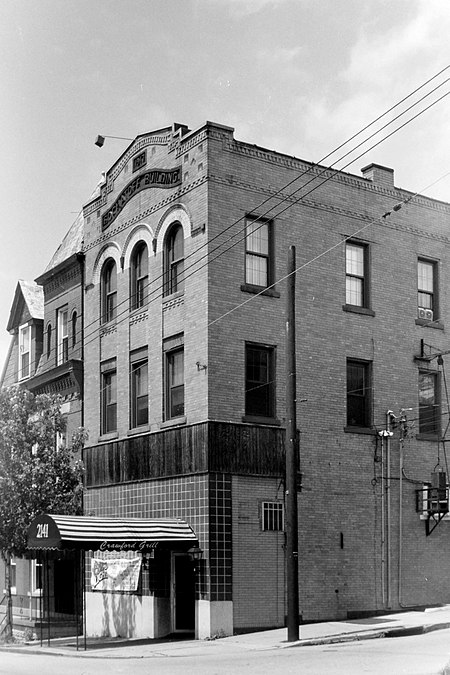
Here is the Crawford Grill three years before it closed, from a picture Father Pitt took in 2000 with a cheap but capable Russian camera called a Lomo Smena 8M. This was the second Crawford Grill, which opened in 1943; the first, which stayed open for a few years after the second opened, had been in the long-since-demolished part of Wylie Avenue on the Lower Hill.
The Crawford Grill was legendary in its time, and it is still a legend among jazz lovers today. It was the last holdout from a whole street of jazz clubs that flourished in the first half of the twentieth century.
Note, by the way, the name at the top of the façade—“Sochatoff Building.” The Hill was a glorious mix of ethnic groups, a place where all races and languages came together and had a good time—Greek and African and Lebanese and Russian and Jewish and German and Chinese.
Of course, the word used by the Powers That Be for that kind of neighborhood was “slum,” and it was the mission of good government to eliminate slums.
It would be oversimplifying things to say that the Hill collapsed because the authorities hated the idea of a place where different races came together in harmony. But it would not be false. There were other forces involved, but that was the biggest one. The destruction of the Hill was deliberate policy, proudly announced and boastfully acknowledged. Slums must be cleared. And the residents? Well, they’d just better not go off and make another slum somewhere else, because we’ll be watching. How can you tell whether a good neighborhood is turning into a slum? Well, if you see races mixing, that’s an infallible sign. Much public policy in the middle twentieth century was determined by the desirability of keeping races separate.
The Crawford Grill thumbed its nose at that segregation. People of all races and classes gathered there because the music was first-rate, and the food wasn’t bad either. The entire Lower Hill, including the original Crawford Grill, was destroyed to create an arid modernist wasteland, but the new Crawford Grill stayed open. Cut off from downtown and with much of its original heart ripped out, the Hill withered and the other jazz clubs faded, but the Crawford Grill stayed open. The 1968 riots after Martin Luther King was assassinated destroyed much of what was left of the business district, but the Crawford Grill stayed open. Even after the rest of the Hill had reached its lowest point, the Crawford Grill remained.
It finally closed in 2003, not from lack of business, but because the building required major repairs that were beyond what seemed reasonable to spend. In fact the club was successful enough that it moved to Station Square—but it lasted only three years there. The Freighthouse Shops part of Station Square was also in decline, though perhaps no one recognized it yet, and the traffic could not support the new club’s considerably higher expenses.
The building still stands today, isolated and forlorn. That splendid Victorian house to its left is gone now, replaced by a vacant lot. A group of neighborhood preservationists bought the building years ago, but no one has been able to do anything with it. It just sits there, with a state historical marker in front of it to remind us that it was something great once upon a time.
If old Pa Pitt were writing a short story for a literary magazine, he would end it by telling you that, late at night, neighbors still hear the wail of a saxophone from somewhere in the heart of the building. That would be the proper ending for the story. As it is, he has only the optimistic hope to offer that some day the neighborhood will come together and the doors will open and the jazz will flow again.

One response to “Crawford Grill”
[…] Greenlee, the Black entertainment magnate from the Hill famous in jazz legend as the owner of the Crawford Grill. Mr. Greenlee bought the equally legendary Pittsburgh Crawfords baseball team, and Mr. Tito […]